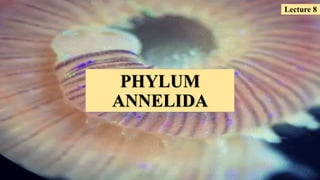
Lecture 8 phylum annelida
- 2. General characteristics • 15,000 species • Large successful phylum in water & on land -include earthworms, sand worms, bristle worms, clam worms, fan worms, leeches • Worldwide distribution: marine, brackish, freshwater and terrestrial • Elongated wormlike body • New body design: hollow tube-within-a-tube • True coelom present • Mesoderm on inside of body wall and outside of digestive system • One of the most successful animal designs • Room for development of complex organs with muscle layers • Allows for circulation of body fluids • Provides hydrostatic skeleton • Some live in tubes they secrete or make with sand or shell
- 3. • Body with well developed metamerism (=segmentation) • Most prominent distinguishing feature seen in just a few other phyla: eg arthropods, chordates • Segments are separated by tissue = septae • Allows more efficient hydrostatic skeleton • Offers a way to achieve greater size: rather than increasing size of each organ • Each organ is repeated in each segment • The segmentation is both external and internal • Essential features of segmentation: • Several systems (eg. Nervous, excretory) show serial repetition • Segmentation is produced during embryonic development NOT the same as asexual budding as in tapeworms General characteristics
- 4. Body form • Most are long and wormlike with head-body- pygidium • Some with bizzare forms • Head (prostomium & peristomium) • Most annelids show some degree of cephalization with a distinct head (=prostomium) tentacles, palps and sensory structures • Peristomium behind prostomium contains the mouth with pharynx and chitinous jaws • Most annelids have paired appendages on most segments parapodia • Parapodia used for; • Locomotion • Respiration • In some, parapodia modified into fans and mucous bags for feeding or to create water currents • Terminal pygidium with anus
- 5. Body Wall • Epidermis a single layer of cells (columnar epithelium) • Epidermis secretes a thin flexible cuticle and setae - small chitinous bristles • Most annelids have setae repeated on each segment (ie. “Bristle worms”) • Used as anchors while burrowing • To prevent capture • Some used for swimming • Or as protection or camouflage • Beneath epidermis is two layers of muscle tissue • Thin layer of circular muscle • Thick layer of longitudinal muscle (obliquely striated) • Body cavity of true coelom • Lined with peritoneum (squamous epithelium) • Lines inside of body wall & outside of digestive tract • Peritoneum also form mesenteries that hold blood vessels and the septae between segments
- 6. Body Wall
- 7. Movement Coelom is filled with fluid (except leeches) which serves as hydrostatic skeleton Annelids have 3 general types of movements: Burrowing: • Waves of peristaltic contractions sweep down body • 1st animal elongates - contraction of circular muscle • 2nd animal sortens - contraction of longitudinal muscle • Setae anchor hind end of body while front end pushes foreword Crawling: • Polychaetes use parapodia alternately to move across surface Swimming: • Mainly polychaetes and leeches undulating body movements
- 8. Alimentary canal • The alimentary canal is complete elongated and tube like structure • It extends from the mouth to the anus
- 9. Coelom • These animals possess a true coelom (true body cavity) • It lies between the layers of mesoderm due to the presence of a true coelom they are called COELOMATES . • The entire coelom is divided into compartments due to the presence of septa.
- 10. Circulatory System Circulatory system • They have closed type circulatory system i.e. the blood flows in blood vessels • The blood is red due to the presence of “hemoglobin” • The major blood vessels are dorsal and ventral blood vessels. • The number of heart is two or more.
- 11. Nervous System • Nervous system is consist of a brain and double nerve cord , with a ganglion in each segment.
- 12. Excretory system • The excretion is by convoluted tube like organ , called nephredia. ,in each segment a pair or more nephredia are present.
- 13. Classes of Annelida Class Polychaeta • The body is elongated and metamerically segmented • For each segment of body prominent body organs are developed called “Parapodia” which bear setae • Setae help in locomotion • Their head is distinct called “Prostomium” • It possesses eyes, tentacles, antennae and bristle of palp. • The sexes are separate and fertilization is external, development take place by trochophore larva Nereis Sabella or peacock worm
- 14. Class Oligochaeta • These animals possess few setae • The body is metamerically segmented consist of many segments • The head is not prominent, eyes and tentacles are also absent. Mouth is present on first segment • Some segments of body are covered with a structure called “CLITELLUM” which is reproductive device • Locomotion takes place by setae • Parapodia are absent Classes of Annelida Earthworm
- 15. Class Hirudinea • The animals of this class are ectoparasites, they live on the outer surface of their host body • Their body is elongated and flattened at both sides • The body consist of definite number of segments, 34 in number • They do not have setae like other annelids • They have suckers at both ends of their body. On the anterior sucker mouth is present, by the help of which they suck blood from the body of the host .The suckers help in their attachment to the host body. • Anus is present on the posterior sucker. Reproduction is sexual . Development of egg takes place in cocoon Classes of Annelida Leach
